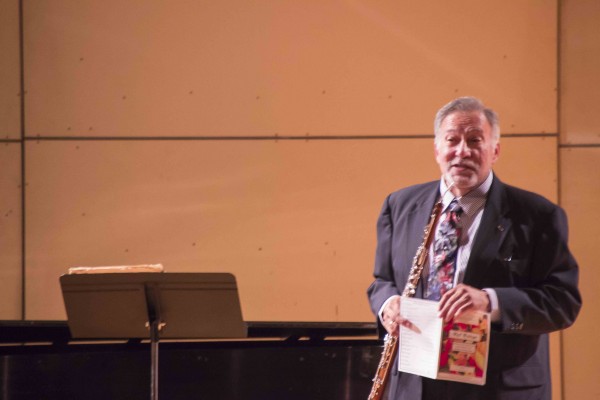
On Tuesday night, Sept. 1, in the Studley Theater, the SUNY New Paltz Music Department kicked off their fall concert series with Fall Foliage; a concert featuring some of the professors who teach SUNY New Paltz students everyday. These professors included Joel Evans (oboe and english horn), the conductor of the school’s Symphonic Band as well as a music history lecturer, Ruthanne Schempf (piano), who teaches music history as well as music theory and Susan Seligman (cello) who teaches music theory, and sight singing/ear training.
The concert featured roughly an hour of music by various composers including Georg Philipp Telemann, Maurice Ravel, William Presser, B.G. DeSylva, Lew Brown and Ray Henderson and Camille Saint-Saens. The variety is something I enjoy whenever there are concerts at this school because the audience gets to hear various different styles and they get to hear music from different time periods as well. For those who attend the shows and don’t always listen to classical music, jazz music or whatever it might be, having a good variety of music is good.
The concert opened with the trio of professors playing Trio Sonata in Eb major from Essercizii Musici by Telemann. This piece featured two movements (Largo and Vivace) and was a good opener for the concert since each professor had a moment to show off their chops while the audience got to hear them all playing together. What surprised me about this concert was that this piece was the last time all three professors would share the stage at the same time, as the rest of the show featured them playing duets or solos.
The next piece, Alborada del Grazioso from Miroirs by Ravel, was a solo piece that featured only Schempf on the piano. This piece was a spanish sounding piece that really showed the skill Schempf has on the piano and was one of the highlights of the evening for me. As someone who has taken her classes before, and is currently taking one, it was really cool to see her in her element; just her and the piano.
The next piece, Passarumbia by William Presser, was a duet featuring Schempf and Evans. The piece, as Evans described, was a combination of two styles of music: a Passacaglia and a Rumba. A Passacaglia is a type of music that revolves around a repeating bass line, or as professor Evans likes to say “a thumping pumping bassline kind of like in a rock song.” A Rumba is a type of Afro-Cuban music. Passarumbia was overall a really interesting piece and the two styles of music complemented each other quite well.
The next piece was one of my favorites of the night. The piece, entitled The Swan from Carnival of the Animals by Saint-Saens, was performed as a duet by professors Seligman and Schempf. An interesting fact about this piece is that the solo cello part (which was performed by Seligman) is typically accompanied by a harp, but the piano (played by Schempf) took the place of the harp. The Swan, along with the other parts of Carnival of the Animals, are some of the most known pieces of classical music and it was very cool to hear one of the parts played live.
Seligman left the stage after The Swan and Evans came back to perform a three song Chinese folk duet with Schempf. The pieces, which were entitled A Horse Runs on the Mountain, Why Is the Flower So Red and A Small Embroidered Bag, were short but each had a particular feel and each told a different story as they were based on poems. The feel of these three pieces was different than all the others in the concert, and the piece that followed these three had a different feeling as well.
You’re the Cream in my Coffee by DeSylva, Brown and Henderson had a jazzy feel to it and although it was one of the shortest pieces of the night, it was one of my favorites because of the feel. It was a bouncy kind of tune that had this light, happy feel to it. Evans and Schempf played this piece as a duet. The concert concluded with another duet by Evans and Schempf with a piece entitled Finale from The Sonata for Oboe by Saint-Saens.
